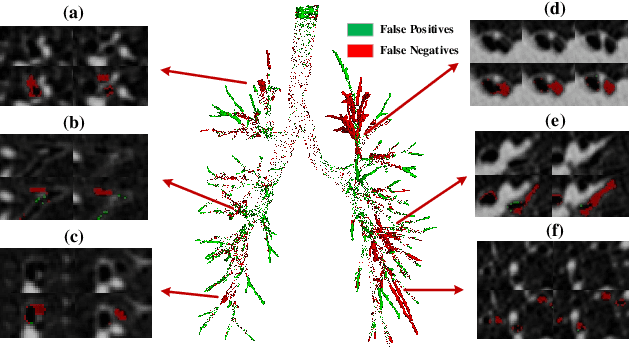Fangfang Xie
From Real Artifacts to Virtual Reference: A Robust Framework for Translating Endoscopic Images
Oct 23, 2024Abstract:Domain adaptation, which bridges the distributions across different modalities, plays a crucial role in multimodal medical image analysis. In endoscopic imaging, combining pre-operative data with intra-operative imaging is important for surgical planning and navigation. However, existing domain adaptation methods are hampered by distribution shift caused by in vivo artifacts, necessitating robust techniques for aligning noisy and artifact abundant patient endoscopic videos with clean virtual images reconstructed from pre-operative tomographic data for pose estimation during intraoperative guidance. This paper presents an artifact-resilient image translation method and an associated benchmark for this purpose. The method incorporates a novel ``local-global'' translation framework and a noise-resilient feature extraction strategy. For the former, it decouples the image translation process into a local step for feature denoising, and a global step for global style transfer. For feature extraction, a new contrastive learning strategy is proposed, which can extract noise-resilient features for establishing robust correspondence across domains. Detailed validation on both public and in-house clinical datasets has been conducted, demonstrating significantly improved performance compared to the current state-of-the-art.
Trajectory optimization of tail-sitter considering speed constraints
Jun 12, 2024



Abstract:Tail-sitters combine the advantages of fixed-wing unmanned aerial vehicles (UAVs) and vertical take-off and landing UAVs, and have been widely designed and researched in recent years. With the change in modern UAV application scenarios, it is required that UAVs have fast maneuverable three-dimensional flight capabilities. Due to the highly nonlinear aerodynamics produced by the fuselage and wings of the tail-sitter, how to quickly generate a smooth and executable trajectory is a problem that needs to be solved urgently. We constrain the speed of the tail-sitter, eliminate the differential dynamics constraints in the trajectory generation process of the tail-sitter through differential flatness, and allocate the time variable of the trajectory through the state-of-the-art trajectory generation method named MINCO. Because we discretize the trajectory in time, we convert the speed constraint on the vehicle into a soft constraint, thereby achieving the time-optimal trajectory for the tail-sitter to fly through any given waypoints.
Alleviating Class-wise Gradient Imbalance for Pulmonary Airway Segmentation
Nov 24, 2020



Abstract:Automated airway segmentation is a prerequisite for pre-operative diagnosis and intra-operative navigation for pulmonary intervention. Due to the small size and scattered spatial distribution of peripheral bronchi, this is hampered by severe class imbalance between foreground and background regions, which makes it challenging for CNN-based methods to parse distal small airways. In this paper, we demonstrate that this problem is arisen by gradient erosion and dilation of the neighborhood voxels. During back-propagation, if the ratio of the foreground gradient to background gradient is small while the class imbalance is local, the foreground gradients can be eroded by their neighborhoods. This process cumulatively increases the noise information included in the gradient flow from top layers to the bottom ones, limiting the learning of small structures in CNNs. To alleviate this problem, we use group supervision and the corresponding WingsNet to provide complementary gradient flows to enhance the training of shallow layers. To further address the intra-class imbalance between large and small airways, we design a General Union loss function which obviates the impact of airway size by distance-based weights and adaptively tunes the gradient ratio based on the learning process. Extensive experiments on public datasets demonstrate that the proposed method can predict the airway structures with higher accuracy and better morphological completeness.
 Add to Chrome
Add to Chrome Add to Firefox
Add to Firefox Add to Edge
Add to Edge